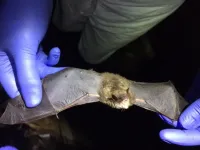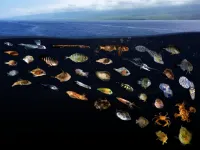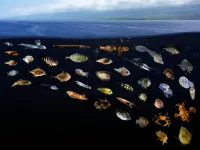(Press-News.org) When health researchers ask pregnant women about their alcohol use, expectant women may underreport their drinking, hampering efforts to minimize alcohol use in pregnancy and prevent development of fetal alcohol spectrum disorders (FASD) in children.
In a recently published study in Alcoholism: Clinical & Experimental Research, University of New Mexico scientists found that pregnant women's reporting of their own risky drinking varies greatly depending on how key questions are worded.
Most women know that alcohol use during pregnancy may harm their unborn child - and that leads to fear of being stigmatized or facing legal consequences when they admit to drinking, says lead author Ludmila Bakhireva, MD, PhD, MPH, professor and director of the Substance Use Research and Education (SURE) Center in the UNM College of Pharmacy.
"We are trying to destigmatize this and get more accurate reports," Bakhireva said. "We're trying to do it in a compassionate way without blaming the mother or inducing shame. Since as many as half of the pregnancies in the U.S. are unplanned, many women may be drinking before they know they are pregnant."
Existing self-reporting tools are suitable for identifying chronic heavy drinking, Bakhireva said, but are less likely to detect episodic binge drinking or moderate alcohol use - which still may pose a risk to the developing fetus.
Bakhireva was joined in the study by SURE Center colleagues Melissa Roberts, PhD, and Dominique Rodriguez, MA, along with Lawrence Leeman, MD, MPH, professor in the UNM Department of Family & Community Medicine, and Sandra Jacobson, PhD, professor in the Wayne State University School of Medicine.
They worked with 121 pregnant women aged 18 to 43, who enrolled in the Ethanol, Neurodevelopment, Infant and Child Health cohort. Each woman was interviewed during the second trimester of pregnancy regarding alcohol use during the month around conception, over the weeks since their last menstrual period and pregnancy recognition and during the past 30 days.
The women were not asked directly about using alcohol while pregnant. Instead, they were asked about the number of drinks they consumed the last time they had any alcohol, the most drinks they consumed over 24 hours since their last menstrual period and their drinking on special occasions, such as holidays and birthdays.
Only 3% of the women reported at least one episode that met the criteria for binge drinking (four or more drinks per occasion) since their last menstrual period on a detailed calendar assessment method which captures quantity and frequency of alcohol use.
But the percentages changed when the questions were asked differently. Twenty percent acknowledged drinking on a special occasion, and 52% reported the equivalent of binge drinking the last time they consumed alcohol. When asked about their maximum number of drinks consumed in 24 hours, 89% acknowledged four or more drinks.
Responses reporting higher use are considered likely to be more accurate, so the researchers concluded that brief, targeted questions to pregnant women about their maximum number of drinks in 24 hours and the total number of drinks at their most recent episode of alcohol consumption were likely to result in much higher self-reported alcohol use.
'Binge drinking in early pregnancy, which can represent alcohol use prior to pregnancy recognition for many women, is predictive of risky drinking later in gestation and is associated with adverse perinatal outcomes," they wrote.
"Asking about alcohol consumption during the timeframe since estimated last menstrual period, instead of asking directly about alcohol use 'in pregnancy,' may also elicit more honest responses. These brief and incisive questions, which can readily be asked by the clinician, generate information critical for the long-term health of the mother and infant."
The researchers cautioned that additional studies are needed to estimate validity of these short questions and that women of all socioeconomic and ethnic backgrounds may be at risk of unsafe drinking in pregnancy.
FASD, which causes developmental disabilities affecting as many as 5% of children in the U.S., is commonly undiagnosed or misdiagnosed, underscoring the need for early identification of alcohol use in pregnancy.
INFORMATION:
Genetics contributes to the risk of developing Alzheimer's disease, and the APOE gene is the strongest genetic risk factor, specifically the APOE4 allele. However, it has been known for a while that the risk due to the APOE4 allele differs considerably across populations, with Europeans having a greater risk from the APOE4 allele than Africans and African Americans.
"If you inherited your APOE4 allele from your African ancestor, you have a lower risk for Alzheimer disease than if you inherited your APOE4 allele from your European ancestor," said Jeffery M. Vance, M.D., Ph.D., professor and founding chair of ...
ATLANTA - FEBRUARY 4, 2021 - Cancer ranks as a leading cause of death in every country in the world, and, for the first time, female breast cancer is the most commonly diagnosed cancer, overtaking lung cancer, according to a collaborative report, Global Cancer Statistics 2020, from the American Cancer Society (ACS) and the International Agency for Research on Cancer (IARC). Data show that 1 in 5 men and women worldwide develop cancer during their lifetime, and 1 in 8 men and 1 in 11 women die from the disease.
The article describes cancer incidence and mortality at the global level and according to sex, geography, ...
Niigata, Japan - Researchers from the Graduate School of Science and Technology at Niigata University, Japan along with their collaborators from Tokyo University of Science (Japan), Yamagata University (Japan) and University of Regensburg (Germany) have published a scientific article which enhances clarity on the understanding of proton conduction mechanism in protic ionic liquids. The findings which were recently published in The Journal of Physical Chemistry B sheds light on the transport of hydrogen ions in these liquids, which opens new avenues for the development of novel energy generation and storage devices.
With ...
Scientists have found genetic differences between bats killed by white-nose syndrome and bats that survived, suggesting that survivors rapidly evolve to resist the fungal disease, according to a Rutgers-led study with big implications for deciding how to safeguard bat populations.
White-nose syndrome has killed millions of bats in North America since 2006, following its introduction from Europe. The syndrome, caused by the fungal pathogen Pseudogymnoascus destructans, is arguably the most catastrophic wildlife disease in history. It has led to unprecedented declines in many North American bat species, including the little brown bat (Myotis lucifugus).
"Our finding that little brown bat populations have evolved, which could be why they survived, has large implications for ...
Lots of us are feeling pretty anxious about the destruction of the natural world. It turns out, humans aren't the only ones stressing out--by analyzing hormones that accumulate in fur, researchers found that rodents and marsupials living in smaller patches of South America's Atlantic Forest are under more stress than ones living in more intact forests.
"We suspected that organisms in deforested areas would show higher levels of stress than animals in more pristine forests, and we found evidence that that's true," says Noé de la Sancha, a research associate at the Field Museum in Chicago, Associate Professor of Biology at Chicago State University, ...
New research published today in the journal Scientific Reports based on the largest-to-date analysis of commercial data on egg-laying hen mortality finds that mortality in higher-welfare cage-free housing systems decreases over time as management experience increases and knowledge accrues.
This finding marks a major turning point in the debate over the transition in housing systems for egg-laying hens from battery cages to indoor cage-free systems, which some egg producers have argued would increase hens' mortality even as it allowed birds to stretch their wings.
The study, authored by Dr. Cynthia Schuck-Paim and others, included data from 16 countries, 6,040 commercial flocks, and 176 million hens in a variety of caged and ...
DALLAS, Feb. 4, 2021 -- Stroke and heart attack survivors can reduce multiple causes of death and prevent further cardiovascular events by drinking green tea, according to new research published today in Stroke, a journal of the American Stroke Association, a division of the American Heart Association. The study also found daily coffee consumption helps heart attack survivors by lowering their risk of death after a heart attack and can prevent heart attacks or strokes in healthy individuals.
Previous research has examined the benefits of green tea and coffee on heart health in people without a history of cardiovascular disease or cancer. Researchers in ...
BOSTON - Medical histories of patients collected and stored in electronic health records (EHR) can be rapidly leveraged to predict the probability of death from COVID-19, information that could prove valuable in managing limited therapeutic and preventive resources to combat the devastating virus, researchers from Massachusetts General Hospital (MGH) have found. In a study published in npj Digital Medicine, the team described how artificial intelligence (AI) technology enabled it to identify factors such as age, history of pneumonia, gender, race and comorbidities like diabetes and cancer as predictors of poor outcomes in COVID-19 patients.
"By combining computational methods and clinical expertise, we developed a set of models to forecast ...
The open ocean is a harsh place for newborn fishes. From the minute larvae hatch from their eggs, their survival depends upon finding food and navigating ocean currents to their adult habitats--all while avoiding predators. This harrowing journey from egg to home has long been a mystery, until now.
An international team including scientists from the Arizona State University Center for Global Discovery and Conservation Science (GDCS), NOAA's Pacific Islands Fisheries Science Center, and the University of Hawai'i at Mānoa have discovered a diverse array of young marine animals finding refuge within so-called 'surface slicks' in Hawai'i. Surface slicks create a superhighway of nursery habitat for more than 100 species of commercially and ecologically ...
To survive the open ocean, tiny fish larvae, freshly hatched from eggs, must find food, avoid predators, and navigate ocean currents to their adult habitats. But what the larvae of most marine species experience during these great ocean odysseys has long been a mystery, until now.
A team of scientists from NOAA's Pacific Islands Fisheries Science Center, the University of Hawai'i (UH) at Mānoa, Arizona State University and elsewhere have discovered that a diverse array of marine animals find refuge in so-called 'surface slicks' in Hawai'i. These ocean features ...




